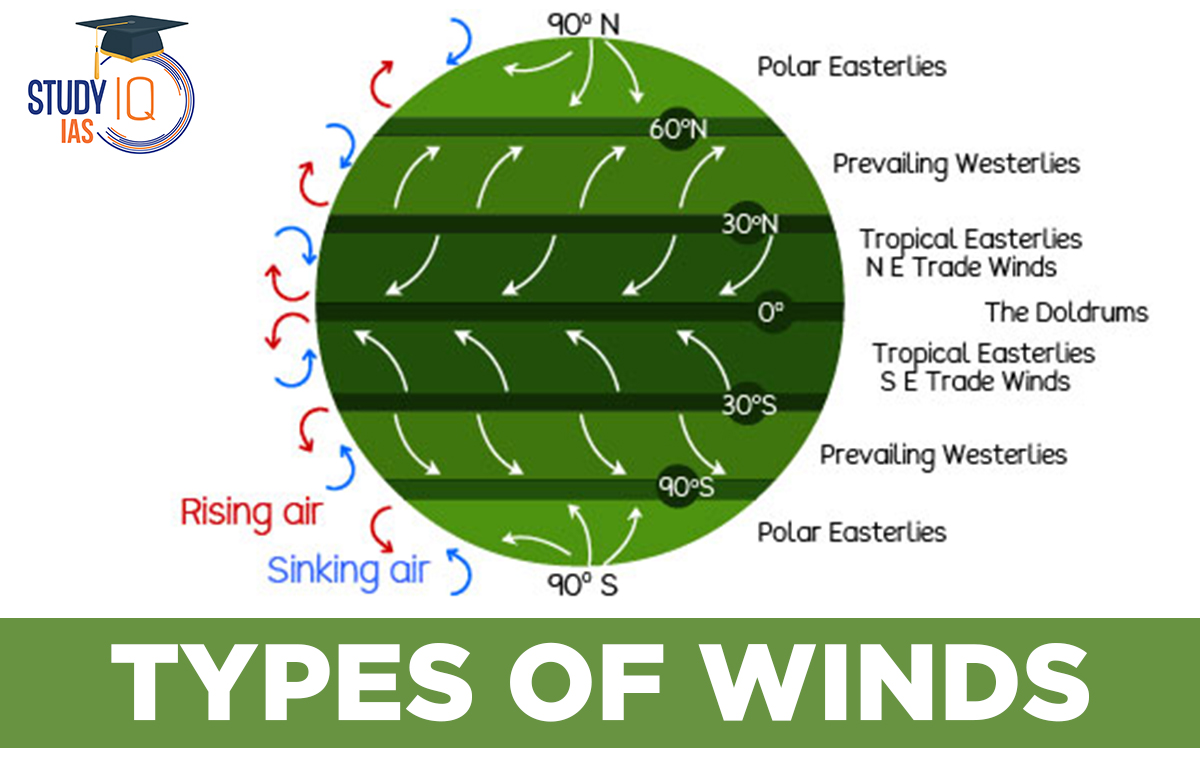Table of Contents
Types of Winds
The Earth’s surface heats unevenly because land warms up faster than water. This causes the air above the hot land to rise, creating a low-pressure area. Cold air from high-pressure areas then moves in to fill the gap, forming winds. Winds help balance the uneven pressure in the atmosphere. An anemometer measures wind speed, while a wind vane shows the direction of the wind.
Read More: Pressure Belts
Classification of Winds
There are majorly three Types of Winds that exist in the world. The winds are categorized or classified under the following categories:
| Planetary winds/Permanent Winds | Periodic Winds | Local Winds |
|
|
|
Read More: Heat Zones of Earth
Types of Planetary Winds
All year long, primary or planetary winds travel in one direction from high-pressure bands to low-pressure belts. They sweep across vast portions of continents and oceans. The planetary wind circulation is made up of trade winds, westerlies, and polar easterlies. The air in the Inter-Tropical Convergence Zone (ITCZ) rises because of convection currents due to high insolation and low pressure.
1. Trade Winds
Winds from the tropics come together at the Intertropical Convergence Zone (ITCZ) and rise into the atmosphere. As this air reaches the top of the troposphere, it moves toward the poles and collects around 30 degrees North and South. Some of this air sinks to the ground, creating a subtropical high. The cooling air at these latitudes also causes it to sink. As the air descends, it flows toward the equator near the surface as trade winds. Due to the Coriolis effect, these winds shift direction: they blow northeast in the Northern Hemisphere and southeast in the Southern Hemisphere. The easterlies from both sides of the equator meet again at the ITCZ. This circular movement of winds creates a tropical cell known as the Hadley Cell.
Read More: Temperature Inversion
2. The Westerlies
In the middle latitudes (30 to 60 degrees), cold air from the poles sinks while warm air rises from the subtropical high-pressure area. These winds are deflected by the Coriolis effect, turning into westerlies in both hemispheres. The westerlies meet along the sub-polar low-pressure belt, where they rise into the troposphere. From there, the air moves away towards the poles and the equator, then descends again above the subtropical and polar high-pressure belts, forming Ferrel cells and Polar cells.
Westerlies vary more in intensity and direction than trade winds, frequently mixing with polar air and moving with cyclones and anticyclones. They are stronger in colder weather. In the Southern Hemisphere, the westerlies are particularly powerful due to the lack of land between 40 and 60 degrees South, earning names like “roaring forties,” “furious fifties,” and “screaming sixties” at those latitudes.
3. The Polar Easterlies
In the Polar cell, winds blow from high pressure in the polar regions to low pressure in the sub-polar areas. Due to the Coriolis effect, these winds turn to become easterlies, known as polar easterlies. Winds from the subtropical and polar high-pressure areas meet and create low-pressure conditions or cyclonic storms. This meeting area is called the polar front.
Read More: Heat Transfer Methods
Types of Periodic Winds
The term “secondary winds” refers to winds that change direction during the year. Other names for secondary winds include seasonal or periodic or cyclical winds. Secondary winds occur all throughout the world in a variety of settings.
1. Monsoons
Seasonal wind direction reversal is a hallmark of monsoons. They are explained as land and sea breezes on a large scale. A detailed description has been provided on the topic of the Monsoon chapter in the Indian climatology section.
2. Land Breeze and Sea Breeze
It is a diurnal cycle of local wind in coastal areas. It is caused due to the differential heating of land and water, which produces low and high pressures. During the day, land heats up faster than water, causing warm air to rise and creating low pressure over the land. Meanwhile, water heats up slowly due to its high specific heat, leading to high pressure over the water. Specific heat refers to how much heat is needed to raise the temperature of a substance. Since water requires more heat to warm up than land, it heats more slowly.
This difference in pressure causes air to move from the high-pressure area over the water to the low-pressure area over the land, creating a sea breeze that cools the coastal areas. Sea breezes start before noon and are strongest in the afternoon. At night, the land cools down faster than the water, creating high pressure over the land and low pressure over the sea. This leads to a gentle wind blowing from the land to the sea, known as a land breeze.
Read More: Isotherms
3. Valley Breeze and Mountain Breeze
Mountain and valley breezes are daily wind patterns that reverse direction. During the day, the sun heats the slopes more than the valleys, creating low pressure on the slopes and high pressure in the valleys. As a result, air moves up from the slopes, and the wind blows from the valley to the slopes, creating a valley breeze, also known as anabatic wind. This breeze can lead to cumulus clouds forming near mountain peaks, resulting in orographic rainfall. At night, the slopes cool down, and the dense, cool air flows down into the valley, creating a mountain breeze, or katabatic wind.
Read More: Structure of the Atmosphere
Types of Local Winds
Local Winds or Tertiary winds is the term used to describe the wind that only blows in a limited area at specific times of the day or year. The difference in temperature and air pressure of a certain area causes the wind type. Tertiary or local winds might be classified as hot, frigid, ice-filled, dusty, or rich. Loo is a particular kind of scorching, ferocious local wind that blows over India’s northern plains. Here we are providing a complete List of Major Local Winds in detail.
Types of Winds UPSC
Planetary or primary winds, trade winds, Westerlies, periodic winds, local winds, monsoon, land, sea, mountain, and valley breeze are some of the several types of winds that might exist. Both for the prelims and the mains of the UPSC IAS Exam, the subject of “Types of Wind” is crucial. Relevant information regarding wind and its types will be provided in this article.


 Desert Climate, Distribution, Climatic C...
Desert Climate, Distribution, Climatic C...
 Deserts of India Map, Features of Thar D...
Deserts of India Map, Features of Thar D...
 Indus Valley Civilization, History, Phas...
Indus Valley Civilization, History, Phas...





















